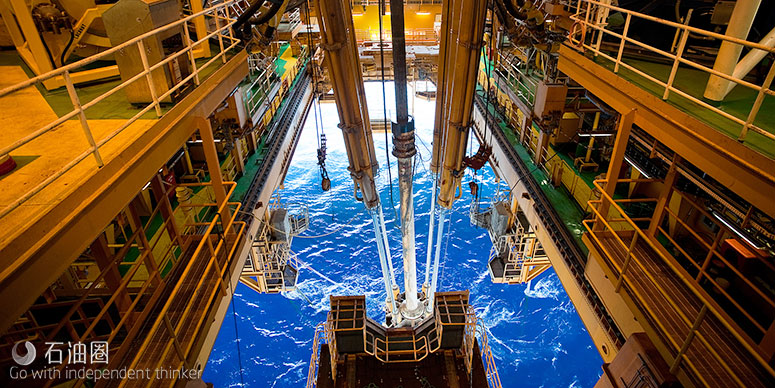As drilling risers are deployed into deeper water, they are subjected to increasingly severe environmental loading due to ocean currents, wind and waves. Also, for drilling risers that are deployed in shallow water, the larger BOPs on sixth- or seventh-generation mobile operating drilling units (MODUs) result in higher wellhead fatigue loading, which potentially compromises the integrity of the well system.
Estimation and management of wellhead fatigue are required to ensure well integrity during offshore drilling operations. The criticality of this topic has increased recently as the fatigue demand due to loads on wellheads has increased with larger BOPs and lower marine riser package stacks, in addition to drilling operations being performed in harsher metocean environments.
The term “wellhead fatigue” refers to the fatigue damage at the hot spots in the wellhead and casing system. Cyclic loads are imparted to the wellhead by the connected riser, as the riser experiences dynamic motions from waves, vessel motions and by vortex-induced vibrations due to currents. The hot spots in the wellhead/casing system include welds, connectors and also the geometrical features in the wellhead itself.
Analytical models of these riser, wellhead and casing systems often predict premature failure due to the required safety factors and conservative modeling. As the design boundaries are extended, field measurements become necessary to assess the accuracy associated with these models. Additionally, such measurements are expected to play a prominent role as quantitative structural integrity management programs such as condition- based maintenance are formalized and mandated.
Stress Engineering Services has developed a real-time fatigue monitoring system (RFMS) and wellhead fatigue monitoring system (WFMS) to provide field measurements of drilling riser and wellhead stress and fatigue in real time.
System design
The RFMS and WFMS calculate the stress in the riser or wellhead system from accelerometers and angular rate sensors housed inside subsea vibration data logger (SVDL) modules, which are installed at strategic locations along the length of the riser and BOP. The SVDL modules are connected via fiber-optic subsea cabling to a central data acquisition system located topside.
The RFMS and WFMS are designed to provide an unprecedented level of actionable information on the health of the drilling riser, wellhead and casing system to the rig crew. By precisely recording the motion of the drilling riser, wellhead and casing system at discrete points in a time synchronous manner, fatigue damage of these components can be determined. Specialized algorithms in the software accurately compute the fatigue damage at any location, despite the complexity of the measured motions. By combining these data with past estimates, an accumulated fatigue damage history is calculated.
The primary driver is the need to acquire accurate, synchronous dynamic measurements in a subsea environment with a high degree of reliability. A secondary but important requirement is to minimize the impact of the system deployment on the riser running operations, thus driving a need for easy installation and retrieval in minimal time.
Case study
The RFMS was initially deployed at two well sites offshore Japan in water depths of 1,180 m to 1,939 m (360 ft to 591 ft). The system successfully collected and processed data from August to November 2012, recording a number of riser excitation events due to weather, vortex-induced vibration and operations while connected and disconnected from the wellhead. The system successfully recorded fatigue damage on the riser.
A comprehensive measurement campaign using the WFMS was designed and deployed on a sixth-generation semisubmersible MODU. The measurement campaign was conducted in a shallow-water region (water depth of 85 m to 95 m [26 ft to 29 ft]) and was subjected to a harsh wave environment. The campaign consisted of a real-time WFMS that measured vessel, riser and stack motions with synchronized accelerometers and angular rate sensors. Additional data including wave and current data, mud weight, slip ring tension, vessel offsets and the tensioner pressures were concurrently measured.
The objective was to quantify any possible conservatism in the riser analyses and thus in wellhead loads and fatigue estimates. In other words, the focus is to address the “load” side of the wellhead fatigue equation, the “resistance” side being out of scope. Any conservatism in loads due to the design of metocean conditions was not the focus of this work. Rather, conservatism in the computation of system response to known (measured) excitation was the focus of the investigation.
Analytical models were driven both in frequencydomain and time-domain with measured environmental excitation, and the analytical predictions of riser and stack motions were compared with motions measured in the field. Approximately six weeks of measured data were used for the data analysis and model validation. Another objective of the monitoring system was to provide real-time information to the rig crew on the riser/stack motions and on wellhead fatigue response and management.
The deployment showed that the RFMS riser and stack motions predicted by analysis using existing modeling techniques match well with the measurements. By extension, the wellhead loads would be accurately estimated from analytical models. This is valid for the analyzed conditions, which correspond to the shallow-water depth (85 m to 95 m), stiff sandy soils, mild to harsh wave environment and small current speeds (no vortexinduced vibrations). With the given metocean conditions, the load side of the wellhead fatigue equation appears to be reasonably predicted by existing analytical techniques both in frequency and time domain. Valuable information was provided to the rig crew, enabling uninterrupted drilling activity despite the harsh conditions.

 石油圈
石油圈
